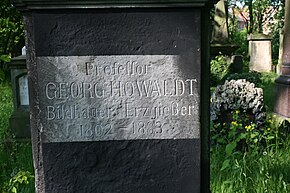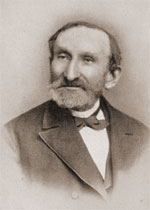Georg Ferdinand Howaldt


Georg Ferdinand Howaldt (born April 8, 1802 in Braunschweig ; † January 19, 1883 there ) was a German goldsmith , sculptor and ore caster .
Life
Georg Howaldt was born in Braunschweig as the son of the Braunschweig goldsmith David Ferdinand Howaldt from Breslau . After attending the orphanage school, he first learned the goldsmith's trade from his father from 1816 to 1821 and then went on to train for six years (including with the silversmith Häberlein in Nuremberg ). In Braunschweig he had already practiced modeling alongside his apprenticeship and, not least because of the friendship he had with Jacob Daniel Burgschmiet in Nuremberg , he turned his work to sculpture and art casting . In 1828 he was succeeded Burgschmiets teacher of modeling at the Polytechnic School in Nuremberg, 1836 teacher of modeling and 1863 professor at the Collegium Carolinum , today's Technical University . Adolf Breymann was also one of his students . In 1874 Georg Howaldt was awarded the Knight's Cross of the Order of Henry the Lion .
Georg Howaldt married Barbara Hechinger in Nuremberg on March 20, 1832 and had five children with her, including the sculptor August, who died before him, as the third child . He died on January 19, 1883 in Braunschweig. His grave in the Magnifriedhof in the immediate vicinity of the Lessing grave has been preserved. Christian Daniel Rauch considered him the best ore caster of his time. This not least because of his knowledge and his skills in creating large monuments in driving work , a craft method that was first described again in modern times by Benvenuto Cellini .
Act
From the remnants of his foundry and workshop between Howaldtstrasse and Hochstrasse , which was first run by his son Hermann Howaldt († December 2, 1891) and then by long-term employee Paul Rinckleben until the end of the business in 1906 and again by his from 1903 Grandson Ferdinand Howaldt (born October 9, 1874) continued as a co-partner of Rinckleben in the artist family until the end of 1906, monumental works that have remained formative for the Braunschweig cityscape emerged: The Lessing Monument (1853) and the Braunschweiger Quadriga with Brunonia on the Braunschweig Castle , both based on designs by Ernst Rietschel . During the manufacture of the Quadriga, he demonstrated his outstanding skill and technique as a copper driver twice when he had to manufacture it again after the fire in Braunschweig Castle. Rietschel's orders gave him the breakthrough and recognition that made it possible to build his own foundry building. The foundry building was sold to Schlaraffia in 1912 and still serves as a club house, known in Braunschweig as the Okerburg .
In view of the reconstruction of the Braunschweig City Palace, the city increasingly remembers its important ore caster. In Brunswick Museum , a finger of Brunonia was recently rediscovered in which even a handwritten note George Howaldts was located, from which emerged about which finger it is. But his work goes far beyond Braunschweig: one of the first monuments that on September 14, 1869 Central Park of New York was erected honoring Alexander von Humboldt . It was made by Georg Howaldt & Sohn in Braunschweig based on a design by Gustav Bläser .
Works (selection)
Lessing monument in Braunschweig
Freiligrath monument and grave in Bad Cannstatt
- Lessing monument based on a design by Ernst Rietschel (1852), cast bronze for Braunschweig
- Monument to Count Blücher based on a design by Franz Bernhard Schiller , lead cast for Altona
- Monument to Mayor August Wilhelm Francke based on a design by Gustav Blaeser (1853), ore cast for Magdeburg
- Monument to the economist Friedrich List based on a design by Gustav Adolph Kietz (1854), cast bronze for Reutlingen
- Braunschweiger Quadriga with Brunonia after a design by Ernst Rietschel, driving work for Braunschweig
- Ernst Moritz Arndt monument based on a design by Bernhard Afinger (1864), cast bronze for Bonn
- Monument to Alexander von Humboldt based on a design by Gustav Blaeser, 1869 for Central Park in New York
- Fountain statue of Heinrich the Lion (1869 and 1874) based on a design by Adolf Breymann for the Heinrichsbrunnen , bronze cast for Braunschweig, shown at the Vienna World Exhibition in 1873 (awarded the silver medal)
- Equestrian statue of Duke Carl Wilhelm Ferdinand of Braunschweig , designed by Franz Pönninger , Vienna, unveiled November 10, 1874
- Equestrian statue of the Black Duke Friedrich Wilhelm von Braunschweig (unveiled November 10, 1874), designed by Ernst Hähnel , Dresden
- Relief for the Hermann Monument based on a design by Ernst von Bandels , 1874
- Bust of Kaiser Wilhelm I based on a design by Heinrich Pohlmann , today in the garden of Villa Staudt in Heringsdorf
- Two angels with swords based on a design by Adolf Breymann for the crypt of the English Prince Consort Albert in Frogmore House near Windsor
- Statue of Pastor Franz Georg Ferdinand Schläger based on a model by Oskar Rassau , erected in Hameln in 1875
- Colossal bust for the grave monument of the writer Ferdinand Freiligrath in the Uff churchyard in Cannstatt , design by Adolf von Donndorf , 1878
literature
- Hermann Kindt: Georg Howaldt and his workshop , in Braunschweiger Kalender 1957, pp. 36–40
- Wolfgang Zorn: Howaldt, Georg. In: New German Biography (NDB). Volume 9, Duncker & Humblot, Berlin 1972, ISBN 3-428-00190-7 , p. 665 f. ( Digitized version ). (Secondary entry)
- Herman Riegel : Georg Howaldt and the art of making sculptures in copper. In: Art history lectures and essays. Westermann, Braunschweig 1877, pp 346-366 ( digitale-sammlungen.de ).
- Theodor Strümpell : Life and work of the sculptor and ore caster Georg Howaldt in Braunschweig; Lecture given at the 9th anniversary festival, March 17, 1883 , Braunschweig 1883 ( digitized version )
- Georg Ferdinand Howaldt . In: Brockhaus Konversations-Lexikon 1894–1896, Volume 9, p. 379.
- Howaldt, Georg . In: Meyers Konversations-Lexikon . 4th edition. Volume 8, Verlag des Bibliographisches Institut, Leipzig / Vienna 1885–1892, p. 744.
- Howaldt, Georg Ferdinand . In: Hans Vollmer (Hrsg.): General lexicon of fine artists from antiquity to the present . Founded by Ulrich Thieme and Felix Becker . tape 17 : Heubel – Hubard . EA Seemann, Leipzig 1924, p. 581 . (with further evidence)
See also
- Further namesake of the Howaldt family
Web links
- Treffpunkt-Howaldt - family pictures and documents
- Treffpunkt-Howaldt - Gender Book 1936
- Alexander von Humboldt Monument in New York
- Frogmore - House, Gardens and Mausoleum Angel with sword in front of the mausoleum
- Equestrian statues today ( Memento from January 29, 2004 in the Internet Archive )
Individual evidence
- ^ Herman Riegel: Georg Howaldt and the art of making sculptures in copper. In: Art history lectures and essays. Westermann, Braunschweig 1877, pp 346-366 ( digitale-sammlungen.de ).
| personal data | |
|---|---|
| SURNAME | Howaldt, Georg Ferdinand |
| BRIEF DESCRIPTION | German goldsmith, sculptor and ore caster |
| DATE OF BIRTH | April 8, 1802 |
| PLACE OF BIRTH | Braunschweig |
| DATE OF DEATH | January 19, 1883 |
| Place of death | Braunschweig |




